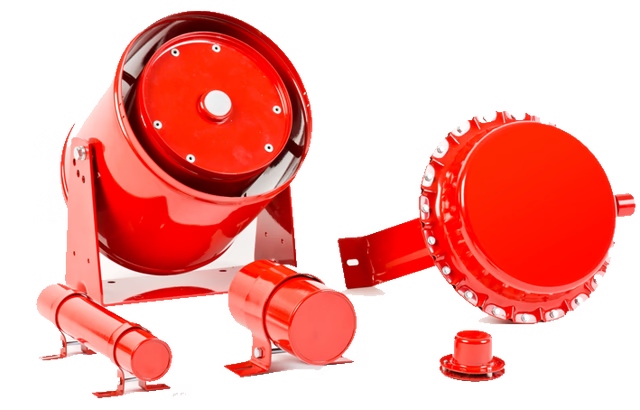
Aerosol extinguishing systems represent a cutting-edge approach to fire suppression, utilizing finely dispersed particles to swiftly and effectively combat fires. These systems consist of aerosol generators, detection mechanisms, and control panels, creating a comprehensive solution for diverse applications. The extinguishing agent, often an environmentally friendly compound, releases as a mist, swiftly removing heat and inhibiting the fire's progression.
One of the key advantages lies in the rapid response time, preventing extensive damage. These systems are versatile, finding applications in critical environments like server rooms, industrial settings, and enclosed spaces. The minimal residue left after deployment distinguishes them from traditional methods, reducing potential damage to equipment and structures. Safety is inherent, with low toxicity levels and adherence to environmental standards.

Aerosol extinguishing systems work by releasing fine particles, often potassium-based, into a protected space when triggered by a fire detection system. These aerosol particles chemically interfere with the combustion process, disrupting the chain reaction and suppressing the fire. Unlike traditional methods, aerosol systems rapidly fill the entire space, reaching concealed areas. The particles are non-toxic, environmentally friendly, and cause minimal damage, making them an efficient and modern solution for fire suppression in various settings, from server rooms to industrial facilities.
An aerosol extinguishing system comprises a few crucial components. The heart of the system is the aerosol generator, responsible for releasing fine particles to suppress fires effectively. Connected to this is the detection system, designed to swiftly identify fire incidents. The control panel serves as the brain, coordinating the entire process with precision. These components work in tandem to ensure a rapid response, minimizing damage and providing an eco-friendly alternative to traditional fire suppression methods. Together, they form a cutting-edge solution that combines science and technology for efficient and environmentally conscious firefighting.
Aerosol extinguishing systems are widely used in many different industries, and they work particularly well for protecting small areas like server rooms, electrical cabinets, and equipment enclosures. Their small size and quick deployment make them appropriate for situations where using conventional firefighting techniques would be difficult. Aerosol systems have low collateral damage and environmentally benign ingredients, making them perfect for protecting delicate equipment. Their broad temperature tolerance and quick fire suppression assure dependability in a variety of environments, from data centers to industrial buildings. Aerosol extinguishing systems are a progressive option for contemporary fire safety solutions because to their efficiency and versatility. Highlight the benefits, such as rapid response times, minimal damage, and environmental friendliness. Showcase real-life examples or case studies where aerosol systems have excelled.
Aerosol extinguishing systems must comply with stringent safety standards and regulations. These guidelines ensure the systems' reliability, effectiveness, and environmental sustainability. Standards such as NFPA 2010 and ISO 15779 dictate design, installation, and maintenance protocols, emphasizing proper testing and certification. Adherence to these regulations guarantees that aerosol systems meet the highest safety benchmarks, minimizing risks and ensuring optimal performance in diverse applications. Compliance with local, national, and international standards is paramount for the successful deployment of aerosol extinguishing systems in safeguarding spaces against fire hazards.
Maintaining the reliability of aerosol extinguishing systems is paramount for effective fire protection. Regular inspections and adherence to manufacturer guidelines ensure peak performance. Periodic checks on the aerosol generator, detection system, and control panel guarantee swift response during emergencies. This proactive approach minimizes downtime and enhances the system's longevity, contributing to a safer environment.
When implementing an aerosol extinguishing system, consider the specific needs of your space. Evaluate the size, layout, and potential fire risks. Ensure proper placement of aerosol generators for optimal coverage. Collaborate with experts to assess compatibility with existing fire safety measures. Comply with safety standards and regulations, prioritizing environmental impact. Establish a routine maintenance schedule to guarantee system reliability. Educate occupants on system functionality and safety protocols. Ultimately, a thoughtful integration of aerosol extinguishing technology will enhance overall fire safety, minimizing damage and response time.
In general, aerosol fire suppression systems are deemed safe provided they adhere to industry standards for design, installation, and maintenance. The safety of these fire suppression systems, which emit a tiny aerosol mist, is ascribed to multiple factors:
Environmental friendliness: Aerosol agents typically have little negative impact on ecosystems and the ozone layer.
Low Toxicity: Aerosol extinguishing agents are generally acceptable for use in populated places because to their low toxicity levels.
Minimal residue: Aerosol systems, as opposed to conventional fire suppression systems, leave less behind, which lowers the possibility of damaging structures and equipment.
Quick Reaction: The ability to quickly activate and suppress a fire helps to reduce its harm.